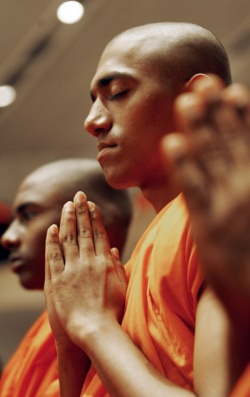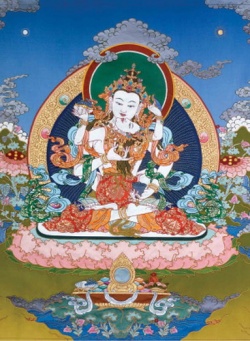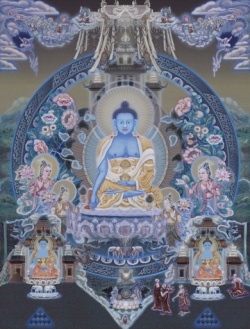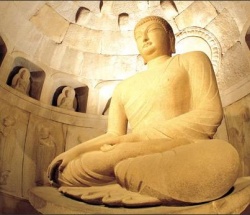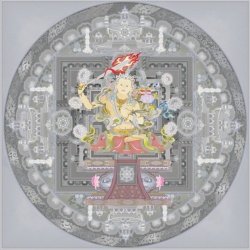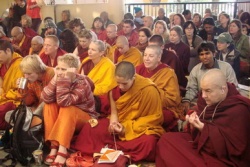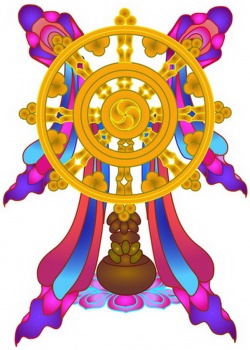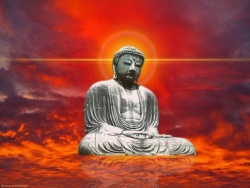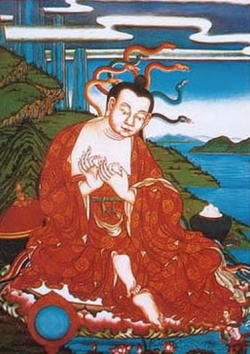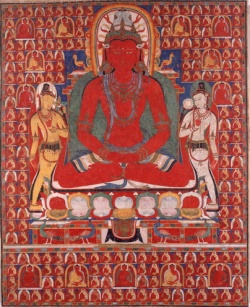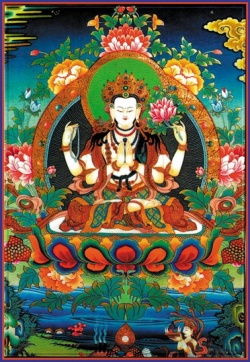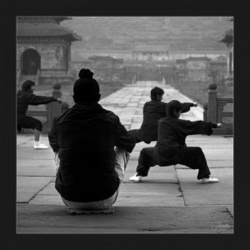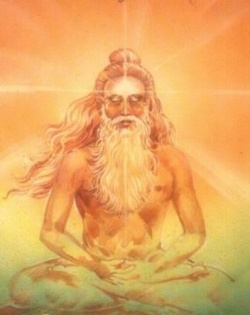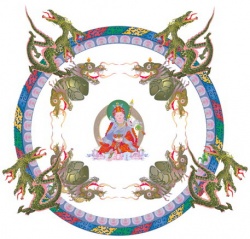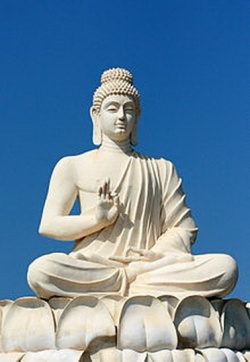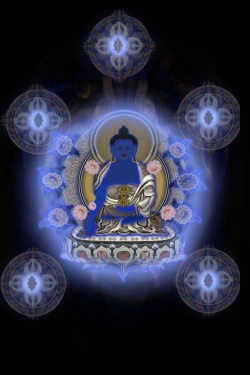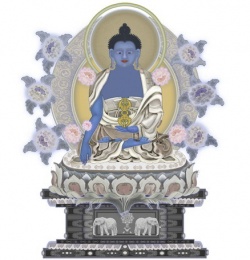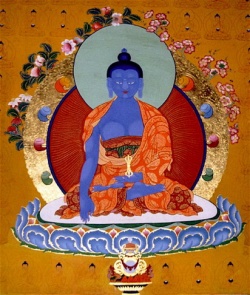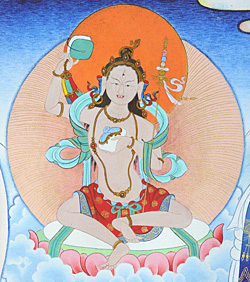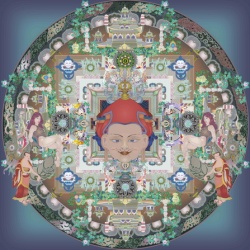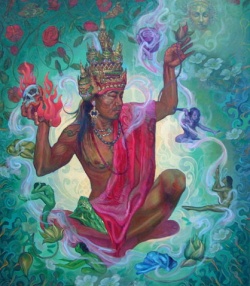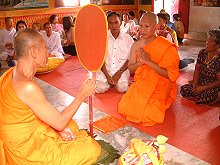The Seventy Points of the Abhisamayalankara
The Seventy Points of the Abhisamayalankara
The Words of Jigme Chökyi Wangpo
Commentary Presenting the Subject Matter of the Great Treatise, the Abhisamayalankara
The great Sage and Lord of Dharma, Maitreya and Manjughosha,
The three founders Nagarjuna, Asanga and Shantarakshita,
Rongzom, Longchenpa, Jigme Chökyi Wangpo and the rest—
Gracious root and lineage masters, grant me your protection!
I will now present an overview of the main body of the great treatise known as Abhisamayalankara, as it is taught in the fifteen verses,[1] following the explanation of Jigme Chökyi Wangpo (Patrul Rinpoche).
In this, there are two main sections:
I. Briefly presenting the main body of the text by means of its principal subject to be elucidated, i.e. the eight topics; and
II. Elaborately explaining the body of the text by means of the seventy points that elucidate [the eight topics].
I. EIGHT TOPICS
This is also divided into a brief presentation and more elaborate explanation.
1. Brief Presentation
As it is said:[2]
The transcendent perfection of wisdom (prajñaparamita)
Is perfectly explained by means of the eight topics.
That is to say that the subject to be explained is the prajñaparamita, and the means of explanation, which will explain it perfectly, are the eight topics.
The Prajñaparamita that is referred to here can be understood by means of the following five aspects:
a) its literal meaning,
b) its definition,
c) illustrations,
d) subdivisions, and
e) the actual versus the nominal.
a) Literal Meaning
As it is said:
It is focused upon the absolute, and is the most sublime among all forms of wisdom, therefore it is transcendent (param; ཕ་རོལ།), and it has arrived at, or will lead one to (ita; ཕྱིན།), non-abiding nirvana.”
b) Definition
Prajñaparamita is the wisdom of directly realizing the non-conceptual simplicity (སྤྲོས་བྲལ།) of all phenomena, which has arrived at, or will lead one to, non-abiding nirvana.
c) Illustration
Any aspect of realization—gained through the three noble paths[4] of the mahayana—into the absence of true reality in all phenomena.
d) Subdivisions
The term prajñaparamita can refer to any of the following:
Their respective definitions and parameters are as follows:
1. Natural prajñaparamita is defined as the objective aspects of the wisdom that directly realizes the non-conceptual simplicity of all phenomena. It is synonymous with the ground prajñaparamita.
Parameters: It is present on the three noble paths of the mahayana.
2. Scriptural prajñaparamita is defined as any scripture—whether the Buddha’s own words or a treatise—whose primary topic of expression is the ground, path or resultant prajñaparamita.
It is insight (རྣམ་པར་རིག་པ།) manifesting as the teachers’ words, expressions and letters.
Illustrations include the seventeen ‘mother’ and ‘son’ prajñaparamita texts as well as Abhisamayalankara.
Parameters: It is present from before the path is entered until enlightenment.
3. Path prajñaparamita is defined as the wisdom that directly realizes the non-conceptual simplicity of all phenomena and leads to non-abiding nirvana.
Illustrations are the five mahayana paths, especially the paths of seeing, meditation and the final path (i.e. the path of no-more-learning).
Parameters: The actual path prajñaparamita is present in the equipoise of the noble followers of the mahayana, whilst a semblance of it is to be found in the mindstreams of those on the paths of accumulation and joining.
4. Resultant prajñaparamita is defined as the wisdom which has arrived at non-abiding nirvana, the ultimate and most supreme direct realization of the non-conceptual simplicity of all phenomena.
An illustration is the magical wisdom of non-duality at the level of buddhahood.
Parameters: It is present only in the continuum of a noble Buddha.
e) The Actual Versus the Nominal
Prajñaparamita is non-dual wisdom,
The very state of a tathagata.
Yet since they have this as their objective,
The term is also applied to the scriptures and the path.[5]
As he states, the ground prajñaparamita and resultant prajñaparamita are the actual (or definitive) prajñaparamita, whereas the scriptural prajñaparamita is merely given the name of prajñaparamita, and the path prajñaparamita has aspects of both the actual and the nominal.
2. Elaborate Explanation
Knowledge of all aspects, knowledge of the path,
Then the knowledge of all,
Completely perfect realization of all aspects,
Reaching the summit, the progressive,
Complete and perfect awakening in a single moment,
And the dharmakaya—these are the eight topics.[6]
As it says, the eight topics are as follows:
Knowledge of all aspects, which is to be attained
Knowledge of the path, which is the means of attainment
Knowledge of the bases, which is to be abandoned
These are the three aspects of wisdom that are to be known.
4. Application of all aspects
5. Culminating application
These are the cause and effect of gaining proficiency (དབང་དུ་བྱ་བ།).
These two are the cause and effect of stability.
Taken together, these last four are the four applications of practice.
The result of practising in such a way is:
8. Dharmakaya
Thus eight are taught.
Each of these is explained according to its definition, illustrations, subdivisions, parameters, definite number, sequence and a denial of any repetition.
1. Knowledge of All Aspects (or Omniscience)
Knowledge of all aspects (or omniscience) is defined as knowing directly, and in a single instant, all aspects, without exception, of things in their real nature and in all their multiplicity.
Subdivisions
It can be subdivided into the omniscience which knows the nature of things and the omniscience which knows all things in their multiplicity.
An illustration of the former is the true cessation present in the continuum of the noble Buddha.
The latter includes both the omniscience which knows the features of all knowable phenomena without exception, and the omniscience which knows the seventy points, the chief amongst all causes and effects. Parameters
It is present only in the continuum of a noble Buddha.
2. Path-Knowledge
Path-knowledge is defined as the path of training that will lead us to realize the authentic limit of reality, once we have realized that the three paths are without any true reality and have perfected, matured and purified. Subdivisions
When divided, there is the path-knowledge that knows the path of the shravakas, the path-knowledge that knows the pratyekabuddha path, and the path-knowledge that knows the path of the bodhisattvas. Parameters
It is present on the five paths of the mahayana. It is also taught that it is present from the mahayana path of seeing until the state of awakening.
3. Base-Knowledge
Base-knowledge is defined as the limited knowledge that realizes all bases to be empty of the self of the individual.
Subdivisions
When the actual base-knowledge is sub-divided, there is the base-knowledge of the shravakas and that of the pratyekabuddhas.
If divisions are made according to how the term is applied, there are five: the base-knowledge that abides in neither existence nor quiescence, the base-knowledge that is distant from the ‘resultant mother’,[7] the base-knowledge that is close to the ‘resultant mother’, the base-knowledge that is unfavourable and the base-knowledge that is a remedy.
Parameters
The actual base-knowledge is present on the five paths of the hinayana, but all the noble ones of the mahayana possess the nominal base-knowledge.
It is also said that it is present in the mind-stream of all noble ones.
4. Complete Application of All Aspects
Complete application of all aspects is defined as the bodhisattvas’ yoga[8] of meditation in which one brings together the three types of non-arising in order to master the realization of the threefold knowledge.[9]
Subdivisions
When divided in terms of its essence and so on, there are twenty applications, and when divided in terms of its aspects, there are 173 subdivisions. Parameters
It is present from the lesser path of accumulation until the end of the tenth bhumi.
5. Culminating Application
Culminating application is defined as the bodhisattvas’ yoga that is based on the complete application of all aspects in which one has gained proficiency in the meditation combining the three types of non-arising.
Subdivisions
There are eight subdivisions: the four culminating applications of ordinary beings, the three culminating applications of the noble ones, and the mistaken practice to be eliminated.
Parameters
It is present from the stage of warmth until the end of the tenth bhumi.
6. Progressive Application
Progressive application is defined as the bodhisattvas’ yoga in which one meditates on the aspects of the threefold knowledge sequentially in order to stabilize the realization in which the knowledge aspects of the threefold knowledge arise all at once.
Subdivisions
There are thirteen subdivisions: the progressive applications of the six transcendent perfections, the six recollections[10] and essential unreality.
Parameters
It is present mainly as an object of study and reflection from the path of accumulation onwards.
The application produced through meditation is present from the stage of warmth [on the path of joining until the end of the tenth bhumi.
7. Instantaneous Application
Instantaneous application is defined as the bodhisattvas’ yoga in which one reaches the culmination of the progressive meditation on the threefold knowledge.
Subdivisions
Merely in terms of conceptual distinctions, it has four subdivisions.[11] Parameters
It is present only at the end of the tenth bhumi.
8. Resultant Dharmakaya
Definitions
The resultant dharmakaya is defined as the ultimate fruition of practising the four applications, endowed with various undefiling qualities.
Subdivisions
It has four subdivisions:
Parameters
It is present only at the level of buddhahood. Definite Number
For an individual to awaken there must certainly be these three: the three aspects of knowledge to be known, the four applications of the path to be practised, and the result which is the dharmakaya.
The Summarizing Lamp says:
Three knowledges as objects to be understood,
Four applications at the time of meditation,
And the ultimate result that is dharmakaya.[12]
Moreover, the three aspects of knowledge are certainly three in number—the knowledge of all aspects which is to be attained, the path-knowledge which is the means of attainment, and the base-knowledge which is a potential pitfall.
Jowo Je, Glorious Atisha said:
At the time of study and reflection,
There is complete ascertainment of the result,
The cause and any unfavourable factors.
The four applications too are fixed in number.
There is the complete application of all aspects, the cause for gaining proficiency, which causes one to develop qualities that had not previously arisen in one’s mind, and its result, the culminating application.
Then there is the progressive application, the cause for gaining stability, which enhances what has already arisen, and its result, the instantaneous application.
The Summarizing Lamp says:
At the time of meditation there is application,
Gaining temporary results, finding stability,
And perfection by reaching the limits of the causal.
The result of such practice is also fixed in number as the single dharmakaya. Sequence
The sequence of the threefold knowledge is based on how they are explained, the sequence of the four applications is based on practice. The four applications and the dharmakaya are given in the sequence of cause and effect.
Denial of any Repetition
There is no repetition between the threefold knowledge and the complete application of all aspects, because the three knowledges each have their own particular aspects, whereas the complete application of all aspects is concerned with all aspects without exception.
Moreover, since the first is taught as something to be known through various definitions and the second is taught as something to be applied in practice, they are not simply repetitions of the same thing.
Yet again, there is no repetition since the first is presented as an object for understanding the nature of total peace and the second is given as a remedy by means of which one overcomes impurities.
The explanation of the various bhumis and the paths of seeing and meditation in the context of the knowledge of all aspects and then their explanation in the context of the path-knowledge serve different purposes, and therefore there is no repetition.
In the first case the explanation is given to illustrate the subject,
the knowledge of all aspects, whereas in the second case it is given to illustrate the path-knowledge that knows the three paths by pointing out its objects.
The explanation of the shravaka and pratyekabuddha paths given in the section on path-knowledge is intended to illustrate the subject, path-knowledge. When they are explained in the section on base-knowledge, it is to point out the base-knowledge that is a remedy by means of which one can be free from conceptual projections.
In the first case, the paths of the shravakas and pratyekabuddhas are taught indirectly by pointing out their opposites, and in the second case they are taught in their own right, so there is no repetition.
There is no repetition between the knowledge of all aspects and the dharmakaya, since they are taught by means of objects and result, or by means of illustration and essence respectively.
II. The Seventy Points
Secondly, there is the elaborate explanation of the body of the text by means of the seventy points.
1. The Ten Factors that Illustrate Omniscience
It is said:
Generation of bodhichitta, spiritual instructions,
The four branches of definite separation,
The foundation of accomplishment—
The nature of the dharmadhatu,
The objects of focus, the objective,
The armour, the activities of engagement,
Accumulation, and definite emergence—
These are the Sage’s knowledge of all aspects.[13]
As it says, there are:
The generation of bodhichitta, which is the nature of the mahayana path,
The spiritual instructions, which are the method for attaining its objective,
The four aspects of definite separation, which come about as a result of the instructions,
The Buddha potential, the nature of the dharmadhatu, which is the basis for attaining accomplishment by practising the instructions unerringly,
The objects of focus for the practice,
The objective of the practice,
Armour-like practice,
Accomplishing the activities of engagement,
The practice of accumulation, and
The practice of definite emergence.
These ten factors point out the nature of omniscience, showing the result by means of its causes, or the subject by means of its objects, and mentioning the most important things to be understood.
The venerable Lord (Atisha) said:
The result of perfecting the ten causes, omniscience itself.
The Pramana vartikka says:
Knowing through this the total number of insects
Holds no purpose for us whatsoever.
It makes known the points to be adopted or avoided,
As well as the methods for doing so.
This is held to be entirely valid,
Although it does not make everything known.
Whether or not one perceives distant things,
One perceives exactly what is required.
1. The Generation of Bodhichitta
The generation of bodhichitta is defined as a special type of mental consciousness endowed with two aspects, inspired by the cause, longing to bring about the welfare of others, and accompanied by the support, longing to attain complete and perfect awakening. Subdivisions
In terms of its essence, it has two subdivisions: aspiration and application. In terms of its scope, it has three subdivisions: the king-like generation of bodhichitta with the great wish; the boatman-like generation of bodhichitta with sacred wisdom; and the incomparable shepherd-like generation of bodhichitta.
In terms of the stages on the paths, there are four subdivisions: the bodhichitta generation of ‘aspirational practice’ on the paths of accumulation and joining, the bodhichitta generation of ‘pure and excellent intention’ on the seven impure bhumis, the bodhichitta generation of ‘complete maturation’ on the three pure bhumis, and the bodhichitta generation of ‘great compassion in which all defilements have been relinquished’ at the level of buddhahood.
In terms of examples, counterparts and properties, there are twenty-two subdivisions.[14] Parameters
It is present from the lesser path of accumulation until the level of buddhahood.
2. Spiritual Instructions
Spiritual instructions are defined as those expressions which instruct one unerringly in the methods for attaining the goal one seeks when generating bodhichitta in the mahayana.
Subdivisions
When divided in terms of purpose, there are the instructions given to prevent previously acquired qualities from dissipating, and teachings given for the sake of acquiring qualities not previously acquired.
When divided in terms of primary and secondary importance, there are firstly the texts of the Buddha’s own words and the treatises, which are special or primary instructions teaching the mahayana path and its result completely and unerringly, and there are also ordinary instructions which teach the mahayana path only partially.
When divided in terms of object, there are ten types of instruction, which instruct as to:
1) the essence of practice itself;
2-5) the objects of focus, which are the four truths;
6-8) the supports, which are the three jewels;
9) the aids, which are the three types of diligence,[15] and the results, which are the five eyes and six supercognitions; and
10) the grounds, which are the paths of seeing and meditation.[16]
Parameters
The authentic instructions are present from the greater path of accumulation of the mahayana onwards and an approximation of them is present from before the path has been entered until the level of buddhahood.
3. Aspects of Definite Separation
The mahayana aspects of definite separation are defined as realizations with five particular features, which develop following the stage conducive to liberation [i.e., the path of accumulation in the mahayana, and are included within the level of aspirational practice. Subdivisions
There are four or twelve subdivisions.[17]
Parameters
They are present only on the mahayana path of joining.
4. Potential
The potential is defined as mind’s actual condition, which is the nature of the dharmadhatu and the support for the thirteen types of practice mentioned here, and which, in its emptiness aspect, provides the cause[18] for the svabhavikakaya, and, in its appearance aspect, the cause for the rupakaya.
Subdivisions
Divided in terms of its essence, there is the naturally present potential and the developing potential. When divided according to the various Dharmas it supports, there are thirteen.[19]
Parameters
As it is taught here, it is present from the lesser stage of warmth (on the path of joining), and, more generally, it is present from the path of accumulation until the end of the tenth bhumi.
5. Focus
Focus is defined as the basis to be understood in order for a mahayana practitioner to eliminate conceptual projections.
Subdivisions
There are eleven subdivisions.[20]
Parameters
It can be directed towards all existent things.[21]
6. Objective
The objective is defined as the ultimate result for the sake of which we engage in the bodhisattva practices.
Subdivisions
There are three subdivisions.[22]
Parameters
It is present at the level of buddhahood.
Practice
Practice, in general, is defined as action which accomplishes the twofold purpose for the sake of unsurpassable enlightenment, which is based on the bodhichitta of the mahayana, and which is endowed with four special features.
The four special features are:
the support of the practice,
the focus of the practice,
the objective of the practice, and
the essence of the practice itself.
These four apply in the following cases.
7. Armour-like Practice
Armour-like practice is defined as such a practice [endowed with the four special features], in which each of the six paramitas includes all six within it. Subdivisions
There are thirty-six divisions.[23]
Parameters
From the path of accumulation until the end of the tenth bhumi.
8. The Practice of Engagement
The practice of engagement is defined as such a practice [endowed with the four special features], in which one engages in the mahayana by means of the principal results of meditation.
Subdivisions
There are nine subdivisions.[24]
Parameters
It is present from the stage of warmth (on the path of joining) until the end of the tenth bhumi.
It is also taught that the straightforward practice of engagement is present from the path of accumulation, and a special form of the practice is present from the middling stage of supreme attribute on the path of joining onwards.
9. The Practice of Accumulation
The practice of accumulation is defined as such a practice [endowed with the four special features], in which one acts to bring about directly one’s own result of great enlightenment.
Subdivisions
There are seventeen subdivisions.[25]
Parameters
It is present from the greater stage of supreme attribute until the end of the tenth bhumi.
Generally speaking, straightforward accumulation is present from the path of accumulation onwards, but here we are referring mainly to the accumulation of direct causes for realizing the emptiness of phenomena and gaining the result of enlightenment.
Therefore, it is taught that the first fifteen practices of accumulation are present at the greater stage of supreme attribute on the path of joining, while the two accumulation practices of the bhumis and the antidote are present on the ten bhumis, which are included within the paths of seeing and meditation.
10. The Practice of Definite Emergence
The practice of definite emergence is defined as such a practice [endowed with the four special features], which leads indubitably to the ultimate destination.
Subdivisions
It has eight subdivisions.[26]
Parameters
It is present on the special path of the tenth bhumi.
2. The Eleven Factors that Illustrate Path Knowledge
It is said:
The stages of eclipsing and so on,
The paths of disciples and rhino-like pratyekabuddhas,
The path of seeing that yields greater benefit,
Bringing qualities in this and other lives.
Functions and aspiration,
Eulogy, veneration and praise,
Dedication, and rejoicing,
The unsurpassable activities of mind,
Accomplishing and the ‘extremely pure’—
The practices of the path of meditation.
This is how the path-knowledge
Of the skilful bodhisattvas is explained.[27]
As the text says, there are:
the branches of the path-knowledge which is generated, such as eclipsing pride and so on,
the path of the shravaka disciples,
the path of the rhinoceros-like pratyekabuddhas,
the path of greater benefit, which brings qualities in this and future lives,
the functions of the path of meditation,
the aspiring path of meditation,
eulogy, veneration and praise for the benefits of aspiration,
the dedicating path of meditation,
the path of meditation of rejoicing, the unsurpassed mental activity,
the accomplishing path of meditation, and
the complete purification of the pure path of meditation.
By means of these eleven illustrating factors that which is to be illustrated—the path knowledge of those who are skilled in bodhichitta and benefitting others—is illustrated just as before.
1. The Five Branches of Path-Knowledge
The five branches of path knowledge are as follows:
the support for generating path-knowledge, which is to be free from the hindrance of manifest pride;
the cooperative condition, generating bodhichitta, which makes the arising [of path-knowledge certain,
the perpetuating cause, awakening the Buddha potential, which makes its development all-encompassing;
its nature, which is not abandoning samsara; and
its function, which is included within the other [four] points.
2. The Path of the Shravaka Disciples
The path of the shravaka disciples is defined as the aspect of a bodhisattva’s knowledge that understands just the selflessness of the individual, by means of the three noble principles, for the sake of guiding disciples who have the shravaka potential, and in order to complete the abandonment and realization of the three vehicles within his or her own mindstream. Subdivisions
If divided, there are the two of the shravakas’ noble path and path of joining.
3. The Path of the Rhinoceros-like Pratyekabuddhas
The path of the rhinoceros-like pratyekabuddhas is defined as the aspect of a bodhisattva’s knowledge that understands the ‘one-and-a-half selflessnesses,’ by means of the three noble principles, for the sake of guiding disciples who have the pratyekabuddha potential, and in order to complete the abandonment and realization of the three vehicles within his or her own mindstream. Subdivisions
If divided, there are the two of the pratyekabuddhas’ noble path and path of joining.
4. The Mahayana Path of Seeing
The mahayana path of seeing is defined as a newly gained insight into the supermundane truth, in which one realizes twofold selflessness.
Subdivisions
It can be divided into sixteen aspects.[28]
5. The Products of the Path of Meditation
The products of the path of meditation are defined as the benefits that are the results of the path of meditation.
Subdivisions
There are six subdivisions.[29]
6. The Aspiring Path of Meditation
The aspiring path of meditation is defined as the tainted path of meditation which is the source of the threefold benefit of the prajñaparamita (ཡུམ་དོན་གསུམ།), and which is apprehended as such with certainty.
Subdivisions
When divided, there are twenty-seven.[30]
Parameters
The aspiring path of meditation for one’s own benefit is present during the post-meditation phase of the second to seventh bhumis. The aspiring path of meditation for the benefit of both self and other is present during the post-meditation phase on the eighth and ninth bhumis.
The aspiring path of meditation for the benefit of others is present during the post-meditation phase on the tenth bhumi.
7. The Triad of Eulogy, Veneration and Praise
The triad of eulogy, veneration and praise is defined as the delight of the buddhas and senior bodhisattvas for a bodhisattva who cultivates the three aspirations, as well as their pronouncement of his or her qualities. Subdivisions
It can be divided into twenty-seven.[31]
8. The Dedicating Path of Meditation
The dedicating path of meditation is defined as the tainted path of meditation on which one dedicates virtuous actions towards complete awakening for the sake of others.
Subdivisions
When divided, there are twelve.[32]
9. The Rejoicing Path of Meditation
The rejoicing path of cultivation is defined as the tainted path of meditation on which one joyfully celebrates one’s own and others’ virtuous actions.
Subdivisions
It can be the rejoicing of a relative or an ultimate subject. Parameters
These tainted paths of meditation are all present from the second to the tenth bhumis.
10. The Accomplishing Path of Meditation
The accomplishing path of meditation is defined as the unimpeded path on the untainted path of meditation, which is the cause for the ultimate realization.
Subdivisions
It has five subdivisions.[33]
11. The Completely Pure Path of Meditation
The completely pure path of meditation is defined as the path of total release on the untainted path of meditation, which is the cause for the ultimate abandonment.
Subdivisions
It is divided into the nine antidotes to the nine factors to be abandoned on the path of meditation.[34]
Parameters
These latter two are present from the second to the tenth bhumis.
3. The Nine Factors that Illustrate Base-Knowledge
It is said:
Due to knowledge, not remaining in samsaric existence,
And out of compassion, not remaining in quiescence,
Distant because of being unskilled in means,
And not distant because of being skilled in means,
Unfavourable factors and their antidotes,
Application and its equality,
And the path of seeing of the shravakas and so on—
This is how the all-knowledge is described.[35]
As it is said, there are:
the base-knowledge of not remaining in samsaric existence due to wisdom,
the base-knowledge of not remaining in quiescence due to compassion,
the base-knowledge of being distant from the ‘resultant mother’ due to not being skilled in means,
the base-knowledge of being close to the ‘resultant mother’ due to being skilled in means,
the base-knowledge that is an unfavourable factor,
the base-knowledge that is an antidote,
the application of engagement,
the equality of application, and
the emerging result of the path of seeing.
That which is to be illustrated—all-knowledge—is asserted to be illustrated by these nine illustrating factors as above.
1. The Base-Knowledge of Not Remaining in Samsaric Existence due to Wisdom
The base-knowledge of not remaining in samsaric existence due to wisdom is defined as the wisdom that causes one to avoid the problems of samsaric existence with the knowledge that understands the absence of true reality.
2. The Base-Knowledge of Not Remaining in Quiescence due to Compassion
The base-knowledge of not remaining in quiescence due to compassion is defined as the wisdom that causes one to avoid the problems of quiescence through the force of generating the superior intention of bodhichitta.
3. The Distant Base-Knowledge Without Skilful Means
The distant base-knowledge without skilful means is defined as being bound by clinging to conceptual attributes in the three categories of (i) what is to be known, (ii) the path, and (iii) its result, and being unable to apply the antidote.
4. The Proximate Base-Knowledge With Skilful Means
The[[[ proximate base-knowledge with skilful means]] is defined as the wisdom that includes superior skilful means and wisdom.
5. Unfavourable Base-Knowledge
Unfavourable base-knowledge is defined as that which is to be abandoned by the bodhisattvas because it is restricted by a mistaken perception of the nature of the bases.
6. Antidotal Base-Knowledge
Antidotal base-knowledge is defined as the realization of the insubstantiality of the bases which acts as an antidote to clinging to their characteristics.
7. The Application of Base-Knowledge
The application of base-knowledge is defined as the path of meditation in which attachment to the bases such as form has been brought to an end, and which indicates, in an indirect way, the applications of the shravakas and pratyekabuddhas. Subdivisions
When divided, there are the four applications that put an end to the attachment to phenomenal entities (ཆོས་ཅན།), the five applications that put an end to the attachment to the nature of phenomena (ཆོས་ཉིད།), and the application of knowing the seven aspects of appearance, making ten in all.[36]
Parameters
It is present from the path of accumulation to the tenth bhumi.
8. The Equality of the Application
The equality of the application is defined as the aspect of meditating on the application of base-knowledge which puts an end to the false presumption of subject and object.
Subdivisions
When divided, there are forty.[37]
9. The Mahayana Path of Seeing
The mahayana path of seeing is defined as a newly gained insight into the truth that is free from the thirty-two conceptual projections, and which indicates, in an indirect way, the path of seeing of the hinayana.
4. The Eleven Factors that Illustrate the Application of All Aspects
It is said:
Aspects together with their application,
Qualities, faults, characteristics,
Factors conducive to liberation and definite separation,
The assembly of irreversible disciples,
The equality of samsaric existence and quiescence,
And unsurpassable pure fields,
These are the completely perfect realization of all aspects,
Together with the last one that is skill in means.[38]
As it is said, there are:
the aspects to be meditated upon,
the application of meditating on the aspects,
the qualities of meditation,
the faults that obstruct meditation,
the characteristics of application,
the path of accumulation, factors conducive to liberation,
the path of joining, conducive to definite separation,
the support, the assembly of irreversible disciples,
the cause of the dharmakaya, the application of the equality of samsaric existence and quiescence,
the cause of the rupakaya, the application of purifying realms, and
the cause of activity, skilful means.
That which is to be illustrated—the application of all aspects—is asserted to be illustrated by these eleven illustrating factors as before.
1. The Aspects
The aspects are defined as the objects or particular facets of knowledge that are to be meditated upon as application. Subdivisions
When divided, there are 173.[39]
2. Application
Application is defined as the mental yoga[40] of meditation in which one combines the threefold knowledge in order to gain proficiency. Subdivisions
There are twenty subdivisions.[41]
Parameters
It is present from the lesser path of accumulation until the end of the tenth bhumi.
3. Qualities
Qualities are defined as those factors which are obtained temporarily and ultimately through the practice of application. Subdivisions
When divided, there are fourteen types.[42]
Parameters
They are present from the mahayana path of accumulation to the state of buddhahood.
4. Faults
Faults, are defined as the activity of Mara, obstructing the development of application and further progress.
Subdivisions
When divided there are forty-six types.[43]
Parameters
They are present up to the seventh bhumi.
Characteristics are defined as the knowledge that illustrates the essence or potential of application.
Subdivisions
When divided, there are ninety-one types.[44]
Parameters
They are present from the mahayana path of accumulation until the end of the tenth bhumi.
6. Factors Conducive to Liberation
Factors conducive to liberation are defined as those factors which help one to gain a particular form of release, but have not yet become the faculties of complete purification.
Subdivisions
When divided, there are five types.[45]
7. Conducive to Definite Separation
That which is conducive to definite separation is defined as the wisdom of the stage of aspiring conduct, which is mainly the outcome of meditation and has the particular aspect of focusing on sentient beings. Subdivisions
When divided, there are twelve types.[46]
8. Irreversible Disciples
Irreversible disciples are defined as those who show signs that they will certainly avoid falling into either [extreme of] existence or peace.
Subdivisions
They are of three kinds: those on the paths of joining, seeing and meditation.[47]
Parameters
From the stage of warmth onwards.
9. The Equality of Samsaric Existence and Quiescence]]
The equality of samsaric existence and quiescence is defined as the application in which one cultivates the realization that samsara and nirvana have no intrinsic reality.
Parameters
An approximation is present from the mahayana path of accumulation, and it is fully evident from the eighth bhumi onwards.
10. The Application of Purifying Realms
The application of purifying realms is defined as removing imperfections in both the environment and inhabitants of the realm in which one will become awakened.
Subdivisions
It has two aspects.[48]
Parameters
An approximation is present from the path of accumulation, and it is present in its distinct form from the eighth bhumi onwards.
11. The Application of Skill in Means
The application of skill in means is defined as the application of knowing when it is timely or untimely to manifest the ten aspects of skill in means.
Subdivisions
When divided there are ten types.[49]
Parameters
An approximation is present from the path of accumulation onwards, and the main application is present from the eighth bhumi.
5. The Eight Points Illustrating the Culminating Application
It is said:
Its signs, progress,
Stability, complete abiding of the mind,
The paths called “seeing” and “meditation”
Which are for the respective
Fourfold conceptions
The fourfold remedies,
Uninterrupted meditative concentration,
And wrong accomplishment
Are the culminating clear realization.[50]
As it is said, there are:
The four culminating applications of ordinary beings:
warmth, indicated by signs
summit, indicated by progress
acceptance, which is indicated by stability in which the twofold welfare is not forsaken
supreme attribute, indicated by the complete abiding of the mind
The three culminating applications of noble beings:
5. the culminating application of the path of seeing
6. the culminating application of the path of cultivation
7. the culminating application of the unimpeded
And:
8. the mistaken practice to be avoid
That which is to be illustrated—the culminating application—is illustrated by these eight illustrating factors as before.
1. Signs
Signs are defined as those factors which indicate that the combined meditation has reached its peak, and which are included within the stage of warmth. Subdivisions
There are twelve subdivisions.[51]
2. Development
Development is defined as the aspect of increase which indicates that the combined meditation has reached its peak, and which is included within the stage of summit on the path of joining.
Subdivisions
There are sixteen subdivisions.[52]
3. Definite Stability
Definite stability is defined as the culmination of the process of stabilizing one’s particular realization of the threefold knowledge and the attitude of not forsaking the welfare of sentient beings, at the stage of acceptance.
Subdivisions
When divided, stability is of two types.[53]
4. Complete Abiding of the Mind
Complete abiding of the mind is defined as the culmination of one-pointed focus on joyfully celebrating the bodhichitta generated by the four types of bodhisattva,[54] at the stage of supreme attribute.
5. The Culminating Application of the Path of Seeing
The culminating application of the path of seeing is defined as a combined meditation which has reached its peak and which serves as an antidote to the concepts to be abandoned through [the [[path of] seeing]].
Subdivisions
When divided, there are the four antidotes to the four types of conceptual thought.[55]
6. The Culminating Application of the Path of Meditation
The culminating application of the path of meditation is defined as a combined meditation which has reached its peak and which serves as an antidote to the concepts to be abandoned through [the path of] meditation.
Subdivisions
When divided, there are the four antidotes to the four types of conceptual thought.[56]
7. The Culminating Application of the Unimpeded
The culminating application of the unimpeded is defined as a combined meditation which has reached its peak and which is the direct cause of omniscience.
8. Mistaken Practice
Mistaken practice is defined as a mind which holds the two truths to be in conflict.
Subdivisions
When divided, there are sixteen types.[57]
6. The Thirteen Points Illustrating the Progressive Application
It is said:
…the progressive
[Has] thirteen aspects.[58]
As it is said, there are:
1-6. the excellent application, the six paramitas,
7-12. the excellent contemplation, the six recollections, and
13. the purifier of these, the application of their essential unreality.
That which is to be illustrated—the progressive application—is illustrated by these thirteen illustrating factors as before.
Definitions
Here, the general definition[59] applies in all cases. Then the progressive application of generosity is defined as a gradual cultivation of generosity, and it is similar for the other five paramitas and the six recollections.[60]
The progressive application of essential unreality is defined as a gradual meditation which follows the realization that all phenomena ultimately lack inherent existence.
Parameters
The parameters have already given above.[61]
7. The Four Points Illustrating the Instantaneous Application
It is said:
One single moment
Brings full and complete awakening:
In terms of its characteristics, it has four aspects.[62]
As it is said, there are:
the instantaneous [application] of maturation,
the instantaneous [application] of non-maturation,
the instantaneous [application] of absence of characteristics,
the instantaneous [application] of the non-duality of all phenomena.
These four illustrating factors illustrate what is to be illustrated—the instantaneous application—as before.
The definition and parameters have been given already above.
8. The Four Points Illustrating the Dharmakaya
It is said:
The essential nature, involving perfect enjoyment,
And likewise the other body of emanation,
And the dharmakaya together with activity,
These are perfectly explained as the four aspects.[63]
As it is said, there are:
the svabhavikakaya, the body of the essential nature,
the sambhogakaya, the body of perfect enjoyment,
the nirmanakaya, the other body of emanation, and
the dharmakaya, together with activity.
These four illustrating factors illustrate what is to be illustrated—the resultant dharmakaya—as before.
The svabhavikakaya is defined as the ultimate true cessation, in which the naturally pure space of the absolute has been purified of even the adventitious stains.
2. Sambhogakaya
The sambhogakaya is defined as a form body (rupakaya) which appears only to the bodhisattvas among the students to be tamed, and which is the ruling condition for the nirmanakaya.
3. Nirmanakaya
The nirmanakaya is defined as a form body (rupakaya) which arises from the ruling condition of the sambhogakaya and which appears as one who tames various pure and impure beings.
Subdivisions
When it is divided, there are the following four:
Birth nirmanakayas, such as our teacher when he took birth in the heaven of Tushita as Prince Shvetaketu.
Supreme nirmanakayas, such as the buddha who displayed the twelve deeds here in Jambudvipa.
Diverse nirmanakayas that manifest [in various ways] in order to tame all kinds of different beings, from gods like Indra down to young girls.
Craft nirmanakayas, such as the manifestation as a lute player for the sake of taming the gandharva Rabga, as well as the appearance of beautiful houses, bridges, pleasure gardens and islands, and sculpted forms, paintings, woven images and cast metal statues.
4. The Dharmakaya together with Activity
Definitions
The wisdom dharmakaya is defined as the ultimate transformation at the level of buddhahood. Subdivisions
When divided, there are twenty-one sets of undefiled qualities.[64] ii. Activity
Activity is defined as the utterly pure enlightened qualities, which arise from the ruling condition of the dharmakaya. Subdivisions
When divided, there are twenty-seven varieties.
Parameters
The aspects belonging to the subject are possessed only by a buddha, but the aspects that exist for the objects of their activity are present even before one enters the path.
This presentation of the subject matter of the great treatise,
Is based on pure scriptural authority and some logical investigation.
Through the slight merit gained by means of this composition
May we be swiftly accepted as followers of the Invincible Lord!
In all our lives may our discipline be as pure as the inside of a lotus,
May we be rich with the wealth of study, reflection and meditation and the three trainings,
And through our unparalleled activity in explanation, debate and composition,
May we be of service to the teachings of the Buddha!
The buddhist monk Thubten Tsöndrü Phuntsok compiled this material from the works of various scholars in order to become more familiar with it in his own mind.
| Translated by Adam Pearcey, Rigpa Translations, 2005. Some of the endnotes were translated from footnotes in the Varanasi edition of the text.
Abhisamayalankara, vv. 4-19. ↩
Abhisamayalankara, v. 4 ab. ↩
This is a quotation from Patrul Rinpoche’s Overview of the Abhisamayalankara (སྤྱི་དོན།). ↩
The paths of seeing, meditation and no-more-learning. ↩
From Summary of the Eight Thousand Verses. ↩
Abhisamayalankara, v. 4cd-5. ↩
Nirvana. ↩
The Namdroling edition of Khenpo Tsöndrü’s text has sems pa’i (attentional), whereas the Varanasi edition and Patrul Rinpoche’s སྤྱི་དོན། both have སེམས་དཔའི། (bodhisattva’s). ↩
I.e. the first three topics: knowledge of all aspects, path-knowledge and base-knowledge. ↩
Recollecting Buddha, Dharma, Sangha, discipline, giving and the gods. ↩
They are given later in the text. ↩
[[ཤེས་བྱའི་ཡུལ་དུ་མཁྱེན་པ་གསུམ༎སྒོམ་པའི་དུས་སུ་སྦྱོར་བ་བཞི༎་འབྲས་བུ་མཐར་ཐུག་ཆོས་ཀྱི་སྐུ༎]] ↩
Abhisamayalankara, vv. 6-7. ↩
The examples or similes are as follows:
1) the earth,
2) fine gold,
3) the waxing moon,
4) fire,
5) a great treasure,
6) jewel-mine,
7) the great ocean,
8) a vajra,
9) the king of mountains,
10) medicine,
11) a spiritual guide,
12) a wish-fulfilling jewel,
13) the sun,
14) a sweet-sounding song of Dharma,
15) a great king,
16) a treasury,
17) a great highway,
18) an excellent horse,
19) a spring of water,
20) sweet-sounding music,
21) the flow of a river and
22) a cloud. ↩
1) The diligence of non-attachment (མ་ཞེན་པའི་བརྩོན་འགྲུས།),
2) completely indefatigable diligence (ཡོངས་སུ་མི་ངལ་བའི་བརྩོན་འགྲུས།), and
3) diligence of taking to the path completely (ལམ་ཡོངས་སུ་འཛིན་པའི་བརྩོན་འགྲུས།).
The first overcomes the laziness of attachment to negative behaviour, the second overcomes the laziness of inactivity, and the third overcomes the laziness of despondency. ↩
This way of counting the ten is based on oral commentary from Dzogchen Rinpoche.
Khenpo Pema Varja, in his སྤྱི་དོན།, counts them slightly differently:
1) the essence of practice itself;
2) the objects of focus, which are the four truths;
3) the supports, which are the three jewels;
4-6) the aids, which are the three types of diligence, and
7) the results, which are the five eyes and
8) six supercognitions; and
9-10) the grounds, which are the paths of seeing and meditation.
The four subdivisions correspond to the four stages of the Path of Joining, i.e., warmth, summit, acceptance and supreme attribute. There are twelve subdivisions when each stage is further divided into greater, middling and lesser stages.
The word cause here is qualified as a ‘cause of removal’ (བྲལ་རྒྱུ།) meaning that its presence provides a ‘cause’ for the removal of the defilements.
1-4) The four stages of the path of joining,
5) the path of seeing,
6) the path of meditation,
7) the antidote, the unimpeded path,
8) the abandonment, the path of total release,
9) the wisdom of emptiness,
10) the skilful means of great compassion,
11) the uncommon dharmas not shared by the shravakas,
12) the stages of accomplishing others’ welfare,
13) the effortless arising of primordial wisdom. ↩
1-3) The virtuous, non-virtuous and neutral actions of the body and so on,
4) the five aggregates connected with all spiritually immature beings,
5) the four dhyana meditations possessed by noble beings,
6) the five perpetuating aggregates which are not a remedy for the view of self,
7) the four applications of mindfulness which are an antidote to this view,
8) the Desire Realm and so on, which depend on causes and conditions,
9) reality itself, which does not depend on causes,
10) the four dhyana meditations which arise in the minds of noble beings, and
11) the ten powers of the Buddha. ↩
Literally: “It is present upon all established bases.” ↩
Great mind, great abandonment and great realization. ↩
The six paramitas are each divided into six. ↩
1) Engaging in the dhyana meditations and formless absorptions,
2) engaging in the six paramitas,
3) engaging in the noble path,
4) engaging in the four immeasurables,
5) engaging in what is beyond conceptual focus,
6) engaging in the complete purification of the three conceptual spheres of subject, object and action,
7) engaging in the objective,
8) engaging in the six supercognitions,
9) engaging in omniscience.
1) Great loving compassion,
2) generosity,
3) ethical discipline,
4) patience,
5) diligence,
6) meditation,
7) wisdom,
8) shamatha,
9) vipashyana,
10) union (of shamatha and vipashyana),
11) skilful means,
12) primordial wisdom,
13) merit,
14) the noble path,
15) dharani,
16) the ten bhumis,
17) the antidote.
The practices of definite emergence:
1) of the three great objectives,
2) of equalness,
3) for the sake of the goal of sentient beings,
4) of effortless and spontaneous accomplishment,
5) beyond the extremes of eternalism and nihilism,
6) of attaining all the objectives of the three vehicles,
7) of omniscience, and
8) of its special path.
Abhisamayalankara, vv. 8-10.
For each of the four noble truths there are the four aspects of acceptance, understanding, subsequent acceptance and subsequent understanding.
1) The virtue of a calm and controlled mind, the direct cause for progress on the path,
2) the virtue of respectfully honouring one’s spiritual guide, the cooperating condition for progress,
3) the virtue of being rid of mental afflictions, which are the internal obstacles,
4) the virtue of not being affected by outer obstacles, such as poisons and weapons,
5) the virtue of gaining unsurpassed awakening,
6) the virtue of turning wherever one stays into a sacred place to be venerated.
The benefit of self, benefit of others and benefit of both self and others are each divided into lesser, middling and greater, and then each of these nine is further subdivided into the three of lesser, middling and greater, giving a total of twenty-seven. ↩
As above, eulogy, veneration and praise are each divided into the three aspects of lesser, middling and greater, and then each of these nine is further divided into lesser, middling and greater degrees.
1) Superior dedication,
2) dedication without conceptual focus,
3) dedication with an unmistaken mind,
4) dedication with the realization of emptiness,
5) dedication while mindful of the nature of the buddhas’ accumulation of merit,
6) dedication with skilful means,
7) dedication without conceptual attributes,
8) dedication with rejoicing at the buddhas,
9) dedication not included within the three realms,
10) lesser dedication,
11) middling dedication, and
12) greater dedication.
1) The intrinsic path of meditation,
2) the path of meditation producing the supreme result,
3) the path of meditation on which one does not fabricate anything conceptually,
4) the temporary path of meditation which involves focusing without conceptual reference, and
5) the path of meditation that brings about the ultimate result of buddhahood. ↩
The nine antidotes are the lesser lesser, middling lesser, greater lesser and so on, corresponding to the nine factors to be abandoned, which are the greater greater, middling greater, lesser greater and so on.
Abhisamayalankara, vv. 11-12.
1) The application that puts an end to attachment to the reality of form and so on, which are the bases of particular characteristics,
2) the application that puts an end to attachment to the reality of characteristics such as impermanence,
3) the application that puts an end to attachment to the reality of the completion and incompletion of qualities,
4) the application of the inherent non-attachment of the subject,
5) the application of the empty nature of phenomena, which does not change into anything else,
6) the application that puts an end to attachment to the reality of the absence of an agent on the absolute level,
7) the application that puts an end to attachment to the reality of the three difficult actions,
8) the application that puts an end to attachment to the reality of the result that is attained according to one’s karmic fortune,
9) the application that puts an end to attachment to the reality of the absence of dependence,
10) the application that puts an end to attachment to the reality of the seven metaphors for appearances.
There are four kinds of absence of presumption for each of the ten applications just mentioned.
The four kinds of absence of presumption are:
1) the absence of any presumption of reality concerning the nature of forms and so on,
2) the absence of any presumption of reality concerning their characteristics and illustrations,
3) the absence of any presumption of reality concerning their divisions,
4) the absence of any presumption of reality concerning subject or object.
Abhisamayalankara, vv. 13-14.
There are 27 aspects of the base-knowledge, 36 aspects of the path knowledge, and 110 aspects of the knowledge of all aspects. ↩
Both editions have ‘mental’ (སེམས་པའི།) rather than bodhisattva’s (སེམས་དཔའི།).
1) The application of non-abiding,
2) the application of non-application,
3) the application of the profound base-knowledge,
4) the application of the path-knowledge which is difficult to fathom,
5) the application of the boundless knowledge of all aspects,
6) the application of great hardship and long duration,
7) the application of gaining prophecies,
8) the irreversible application,
9) the application of definite emergence,
10) the unimpeded application,
11) the application of proximity to awakening,
12) the swift application,
13) the application of benefitting others,
14) the unfluctuating application,
15) the application of seeing neither dharma nor anti-dharma,
16) the inconceivable application,
17) the application of essential non-conceptuality,
18) the application granting the precious fruition,
19) the completely pure application, and
20) the application with established limits.
1) Overcoming the power of Mara,
2) being known by the enlightened mind,
3) being seen with enlightened vision,
4) approaching awakening,
5) gaining four kinds of greatness: the greatness of never being separate from the buddhas, the great advantage of being born in higher realms, the great fruition of enlightenment and the great result of benefitting others even after nirvana,
6) studying the prajñaparamita in a land where it is present, such as Partani,
7) perfecting the undefiled qualities of the six paramitas and so on,
8) becoming a teacher of the Dharma,
9) being undeterred by mara,
10) gaining uncommon sources of virtue,
11) accomplishing what one is committed to accomplishing,
12) taking hold of the great fruition of awakening,
13) accomplishing the welfare of sentient beings, and 14) discovering the complete words and meaning of the prajñaparamita. ↩
There are twenty faults that one possesses oneself, twenty-three that can come from oneself or others and three that come from others. ↩
There are four main divisions: knowledge characteristics, special characteristics, functional characteristics and essential characteristics.
Within the first category there are sixteen knowledge characteristics of the base-knowledge, sixteen of the path-knowledge and sixteen of the knowledge of all aspects, making forty-eight in total.
Then there are sixteen special characteristics, eleven functional characteristics, and sixteen essential characteristics. ↩
1) Faith in the buddhas and so on,
2) diligence in the practices of the six paramitas,
3) mindfulness of the aspects of the prajñaparamita,
4) non-conceptual meditative concentration,
5) wisdom which knows that all phenomena are beyond conceptual attributes. ↩
The stages of warmth, summit, acceptance and supreme attribute, each of which is further divided into greater, middling and lesser stages. ↩
There are twenty signs of an irreversible disciple on the path of joining, sixteen signs of an irreversible disciple on the path of seeing and eight signs of an irreversible disciple on the path of meditation. ↩
The application of purifying the outer environment and the application of purifying the inhabitants. ↩
1) Transcending the four maras,
2) avoiding all extremes,
3) acting according to former aspiration prayers,
4) being unlike the shravakas and pratyekabuddhas,
5) being free from attachment,
6) avoiding conceptual focus because of meditating on the liberation door of emptiness,
7) not apprehending conceptual attributes because of meditating on the liberation door of transcending signs,
8) having no expectations because of meditating on the liberation door of transcending aspirations,
9) being skilled in explaining the signs of irreversibility, and 10) having a limitless knowledge of how to apply all the skilful methods of the bodhisattvas. ↩
Abhisamayalankara, vv. 15-16.
There are six signs which occur in dreams, two which occur both in dreams and during the waking state and four which occur only while one is awake.
During dreams:
1) Recognizing the dream-like nature of phenomena,
2) not feeling enthusiasm for the states of shravakas and pratyekabuddhas,
3) seeing the buddhas teach,
4) seeing the buddhas display miracles,
5) recognizing one is dreaming whenever experiencing fear and so on,
6) remembering to purify realms. During dreams and waking:
7) Pacifying harm to the environment by uttering words of truth, and
8) pacifying harm to sentient beings by words of truth. During the waking state:
9) following an outer and inner spiritual guide,
10) training in the paramitas,
11) not being attached to phenomena, and
12) approaching enlightenment.
The development of eight mainly internal merits and eight mainly external merits.
1) Reflecting on the meaning of the prajñaparamita and teaching it to others,
2) continually reflecting on the meaning of the prajñaparamita,
3) gaining fearless acceptance of the nature of phenomena,
4) not focusing conceptually on enlightenment and its causes,
5) gaining greater merit than the merit earned by ordinary beings through the practice of the ten virtues and meditative absorption,
6) protecting the welfare of the gods,
7) vanquishing maras,
8) revering other bodhisattvas as if they were equal to the buddhas,
9) skilfully avoiding rebirth in the form and formless realms, even though practising these meditative absorptions,
10) securing the special buddha potential by eliminating the shravaka and pratyekabuddha potentials,
11) increasing the potency of bodhichitta and so on, the causes of buddhahood,
12) not developing attitudes that are opposed to the paramitas,
13) not feeling attachment to anything from visible form up to omniscience,
14) understanding how to include all the paramitas within the mother prajñaparamita,
15) gaining all excellence through training in the prajñaparamita, and
16) coming close to buddhahood by relinquishing all views.
Stability of realization for one’s own sake and stability of compassionate skill-in-means for the sake of others. ↩
These four are explained in various ways. According to one version they are: 1) the bodhisattva who has first entered the vehicle, 2) the bodhisattva engaging in activity, 3) the irreversible bodhisattva, and 4) the bodhisattva who is a single rebirth away [from buddhahood.
The four antidotes to the imputational aspects of the four types of conceptual thought, which are: 1) percept-thoughts of engaging, 2) percept-thoughts of avoiding, 3) perceiver-thoughts of the substantial, and 4) perceiver-thoughts of the imputed. ↩
The co-emergent aspects of the four types of thought mentioned above.
1) Believing that the mental focus produced by the teaching on how all conditioned and unconditioned phenomena are devoid of reality is untenable because if it were tenable, it would be an object of dualistic perception.
2) Believing the method of realizing that all phenomena lack true reality is untenable because if there is a mode of realization there must be something that is realized.
3) Believing omniscient wisdom to be untenable because it is said that it does not focus on real or unreal entities, yet if it is omniscient it must have these two objects.
4) Believing the relative and absolute truths to be untenable because it is taught that in the essence of reality itself they are indivisible, and yet if there are two they must be separable.
5) Believing the trainings in generosity and so on to be untenable because it is taught that one should not conceive of a giver, gift or recipient, and yet if there is an object there must be all three.
6) Believing that the Jewel of the realized Buddha is untenable because it is taught that there is nothing to be realized. 7) Believing that the Jewel of the Dharma is untenable because it is taught that cessation and the path are merely imputations. 8) Believing that the Jewel of the Sangha is untenable because it is taught that all phenomena are beyond development and reduction.
9) Believing that a subject having skilful methods such as generosity is untenable because it is taught that there should be no conceptual focus on subject, object or action.
10) Believing that the Buddha’s realization is untenable because realization of real things, unreal things, both and neither is refuted.
11) Believing it is untenable to label the perception of the aggregates and so on as permanent and so on, because it is taught that notions such as permanent and impermanent are similar in being mere conceptual elaboration.
12) Believing the teaching that the bodhisattvas meditate on all three paths is untenable because it is taught that they do not manifest the fruition, the nirvana of the shravakas and pratyekabuddhas.
13) Believing that the antidote is untenable because it is taught that there is nothing to adopt.
14) Believing that adverse factors are untenable because it is taught that there is nothing to abandon.
15) Believing that general and uncommon characteristics are untenable because it is taught that all phenomena are beyond characteristics and illustration.
16) Believing that practising a path with the attainment of omniscience as its objective is untenable because that which is to be cultivated lacks general and specific characteristics.
From Abhisamayalankara, v. 17.
Progressive application is defined as the bodhisattvas’ yoga in which one meditates on the aspects of the threefold knowledge sequentially in order to stabilize the realization in which the knowledge aspects of the threefold knowledge arise all at once. ↩
Patrul Rinpoche (སྤྱི་དོན།) gives the definition for the recollection of the Buddha as:
On the absolute level not focusing conceptually on the qualities of the tathagatas, but relatively recollecting them properly in the proper sequence.
For the next five, i.e., Dharma, Sangha, discipline, giving and the gods, replace ‘the qualities of the tathagatas’ with the following: ‘virtuous, non-virtuous and neutral Dharma’, ‘the assembly of irreversible disciples’,
‘the three sets of vows’, ‘giving the Dharma and material giving’, and ‘the noble ones born among the gods’. ↩
i.e., It is present mainly as an object of study and reflection from the path of accumulation onwards. The application produced through meditation is present from the stage of warmth [on the path of joining until the end of the tenth bhumi. ↩
From Abhisamayalankara, v. 17.
Abhisamayalankara, v. 18.
1) The thirty-seven factors of enlightenment,
2) four immeasurables,
3) eight complete freedoms,
4) nine successive states of meditative absorption,
5) ten totalities,
6) eight spheres of dominant perception,
7) absence of mental affliction,
8) intending wisdom,
9) six supercognitions,
10) four precise and perfect knowledges,
11) four complete purities,
12) ten masteries,
13) ten powers,
14) four fearlessnesses,
15) three types of non-concealment,
16) three applications of mindfulness,
17) non-postponement,
18) complete subjugation of habitual tendencies,
19) great compassion,
20) eighteen unshared qualities, and
21) complete omniscience.
1) The activity of pacifying beings’ suffering,
2) establishing beings in the four means of attraction,
3) establishing them in the realization of the four truths,
4) establishing them in accomplishing the welfare of sentient beings,
5) establishing them in the six paramitas,
6) establishing them on the path to enlightenment,
7) establishing them in the realization that all phenomena are simply designations,
8) establishing them in the realization beyond conceptual focus,
9) establishing them in the complete maturation of sentient beings,
10) establishing them on the uncommon path of the bodhisattvas,
11) establishing them in dispelling attachment,
12) establishing them in the ways to gain awakening,
13) establishing them in the purification of realms,
14) establishing them in the certainty separated by a single birth,
15) establishing them in accomplishing the infinite welfare of sentient beings,
16) establishing them in gaining mastery over immeasurable virtuous qualities, such as serving the buddhas,
17) establishing them in perfecting the factors of enlightenment,
18) establishing them in the inexhaustible nature,
19) establishing them in the wisdom of seeing the truth,
20) establishing them in the nature of abandonment,
21) establishing them in the wisdom that realizes the absence of a basis for conceptual attributes,
22) establishing them in the way to purify the factors to be abandoned,
23) establishing them in the ultimate gathering of antidotes,
24) establishing them in the realization of the inseparability of appearances and emptiness,
25) establishing them in nirvana,
26) establishing them in meditation on natural emptiness,
27) establishing them in the realization of the omnipresence of the dharmadhatu. ↩
Maitreya.

